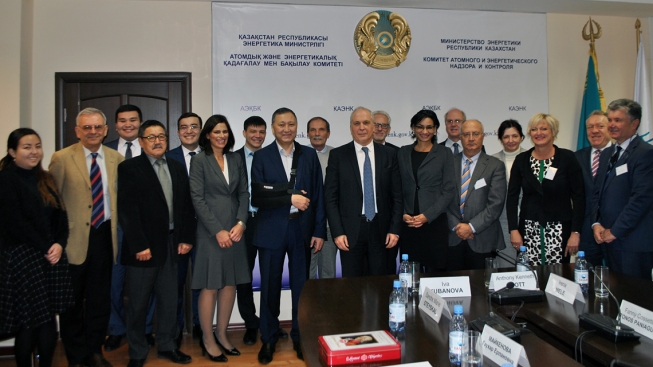IAEA Reviews Kazakhstan’s Nuclear Power Infrastructure Development
An International Atomic Energy Agency (IAEA) team of experts has concluded an eight-day mission to Kazakhstan to review the country’s infrastructure development for a nuclear power programme. The Integrated Nuclear Infrastructure Review (INIR) mission was carried out at the invitation of the Government of the Republic of Kazakhstan.
Due to a desire to reduce reliance on fossil fuels, diversify primary energy sources and curtail greenhouse gas emissions, Kazakhstan is considering the potential role for nuclear power in the country’s energy mix.
The INIR team, in its closing meeting on 7 November 2016 in Astana, concluded that Kazakhstan has developed a considerable base of knowledge and experience in nuclear activities. The team made recommendations and suggestions aimed at assisting Kazakhstan in making further progress in its nuclear infrastructure development.
“Kazakhstan has undertaken several studies over a number of years and has developed a good understanding of all the infrastructure issues described in the IAEA Guide Milestones in the Development of a National Infrastructure for Nuclear Power,” said team leader Milko Kovachev, Head of the IAEA’s Nuclear Infrastructure Development Section.
The INIR mission reviewed the status of 19 nuclear power programme infrastructure issues using the IAEA Nuclear Energy Series Technical Report (NG-T-3.2 Rev.1) Evaluation of the Status of National Infrastructure Development. Prior to the INIR mission, Kazakhstan prepared a Self-Evaluation Report covering all infrastructure issues using this evaluation methodology and submitted the report and other relevant supporting documents to the IAEA.
The INIR team, comprising international experts from the Russian Federation, Spain, the United Kingdom as well as IAEA staff, highlighted areas where further action would benefit Kazakhstan, including:
- Developing a comprehensive report that summarizes the assessment of all nuclear infrastructure issues.
- Continuing the assessment of its legal and regulatory framework for the nuclear power programme.
- Ensuring that the key responsibilities and options with respect to spent fuel and radioactive waste management are developed.
- Developing a plan for establishing a competent owner/operator.
The team also identified three good practices that would benefit other countries considering the introduction of nuclear power:
- Early assignment of responsibilities for the development of the future owner/operator
- Use of a non-governmental organization to carry out stakeholder involvement activities including outreach to parliamentarians, visits to nuclear facilities and institutions in other countries and the early establishment of a nuclear information centre.
- Use of a government commission and an expert working group with representatives from all relevant institutions to review the initial site survey and to take into account lessons learned from the Fukushima Daiichi accident.
Kazakhstan, the world’s largest uranium producer, is developing capabilities to implement all stages of the front end of the nuclear fuel cycle. It has a well-developed scientific research base, including three research reactors in operation and several other nuclear installations. It also has 25 years of experience operating the BN-350 fast breeder reactor, which is currently under decommissioning. More than 80 percent of electricity in Kazakhstan is currently produced from fossil fuels.
Batyrzhan Karakozov, Director of the Department for Atomic and Energy Projects Development, in the Ministry of Energy of the Republic of Kazakhstan, welcomed the outcome of the INIR mission. “The conclusions will be very useful to us. The discussions have given us new insight into some of the issues, which we had not noted previously,” he said.
Image: IAEA INIR mission: International and IAEA experts with representatives from Kazakhstan (Photo credit: the Department for Atomic and Energy Projects Development, Ministry of Energy, Republic of Kazakhstan). Photo courtesy of IAEA

